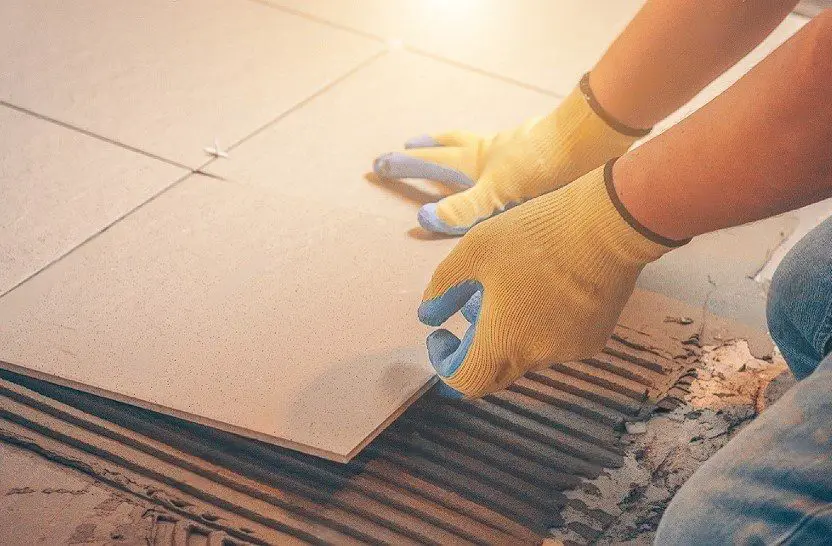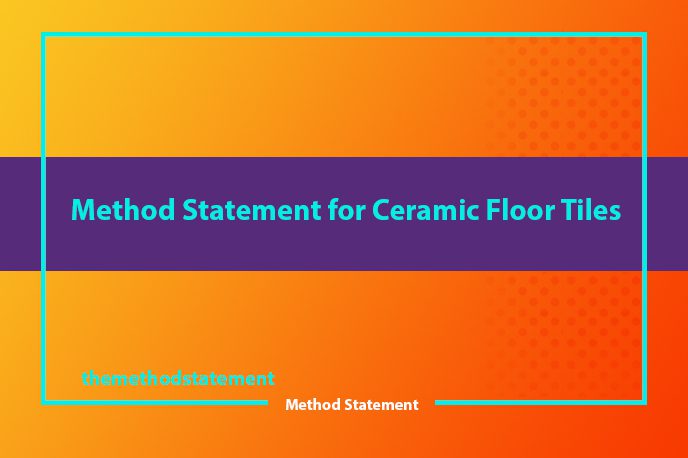Table of Contents
- What is Method Statement for Ceramic Floor Tiles?
- Activities associated with the method for laying ceramic tiles include:
- Structured Method Statement for Ceramic Floor Tiles
- The Scope of Method Statement for Ceramic Floor Tiles
- Insights for QA/QC Engineers related to inspection (ITP) for post-floor tiling installations
What is Method Statement for Ceramic Floor Tiles?
The method statement for ceramic floor tiles encompasses the preparation of the surfaces, mixing and applying the adhesive or mortar materials, laying and grouting of tiles, and cleaning/protection of the finished work.
Floor tiles are typically manufactured materials such as ceramic, stone, vinyl, etc. which are laid upon an existing floor surface as a means of providing a hardwearing durable surface. Aside from that floor tiles also enhance the aesthetic feature of the surfaces as it covers the floors.
Activities associated with the method for laying ceramic tiles include:
- Planning and setting out for the laying of tiles as per the approved shop drawings
- Preparation and approval of mock-up
- Assessment of work environment for hazards and risks
- Preparation of existing or new surfaces to be covered with tiles
- Setting out the position and pattern of tiles to be laid
- Mixing of sand-cement mortar, adhesive materials, and grout
- Laying tiles to adhesive/mortar bed, placement of tile spacers, etc.
- Cleaning of excess materials such as mortar, adhesive, and grout from the finished tile surface
- Selection and use of personal protective equipment
- Strict compliance and implementation of Safety Requirements and Project Specifications to complete the work both for either floor and wall tiling
Structured Method Statement for Ceramic Floor Tiles
1. PURPOSE
This method statement defines the activities and the sequences which are to be carried out and describes in general, the methodology to be used in work execution related to ceramic floor tiling works to ensure compliance with the conditions of the contract, contract specifications, and Health, Safety and Environmental requirements consistent with the approved drawings, relevant specifications, and BOQ.
2. SCOPE
This method statement specifically addresses the ceramic tiling works in general for (Name of Project) at (Locations in the project) and as shown in the drawings.
3. REFERENCES, STANDARDS & SPECIFICATIONS
Project specifications and BOQ
Project Quality Plan
Project HSE Plan
Quality Control Procedures
Contract Drawings and Specifications
Manufacturers’ brochures/ literature and other details as a part of this method statement.
All work shall be executed in compliance with the requirements of Project Specifications & Emergency Response Procedures, and other applicable standards
Approved drawings for constructions with codes A and B for works, materials approval submitted/ to be submitted as applicable, and related approved method statement & ITPs (Inspection and Test Plan)
4. DEFINITIONS AND ABBREVIATIONS
PM Project Manager
CM Construction Manager
PE Project Engineer
QCM Quality Control Manager
QCE Quality Control Engineer
SM Safety Manager
SR Surveyor
SF Section Foreman
QCP Quality Control Procedure
ITP Inspection and Test Plan
ITL Independent Test Laboratory
BOQ Bill Of Quantities
MS Method Statement
FM Form
NCR Non-Conformance Report
ITR Inspection & Test Request
5. RESPONSIBILITIES
The Project Manager is responsible for the preparation and approval of this work procedure.
The Construction Manager and/or his nominee are responsible for the overall execution of the works in accordance with the steps outlined in this procedure and consistent with the approved project schedule.
He shall be responsible for controlling the coordination between all involved parties to ensure Safety, Quality, controlling the progress of work, civil and MEP clearance prior to starting tiling work, and ensuring final approval is obtained prior to starting the next activity.
Notifying the QC engineer and issuing the checklist (inspection request for approval/checklist – Annex A, including all clearances as applicable in a timely manner when work is ready for inspection.
Accompanying the Engineer’s representative for ongoing inspection and obtaining his approval to proceed with the next activity.
The QA/QC Department is responsible for the overall inspection and documentation of works in compliance with the work procedure and Project Specifications and shall be responsible for coordination with Client/Consultants for inspection activities and close out of the NCR/ SON, if any, with Consultants representatives.
The Survey Department is responsible for all the layouts / setting out and for establishing the reference elevations related to the work.
See Also: Method Statement for Architectural Works
6. PROCEDURE
The Scope of Method Statement for Ceramic Floor Tiles
1. Materials Handling on Worksite and Storage
Materials shall be received in parts as per site requirements and in standard boxes and/or packs, pallets, etc. Materials shall be stored in the proper way and handled as per manufacturers’ recommendations if any.
Obtain each color, grade, finish, type, composition, and variety of tiles from a single source. For grout and setting materials, obtain ingredients of uniform quality from one manufacturer for each cementitious and admixture component and from one source or producer.
2. Preliminary in Tiling Works
Work shall comply with all project specifications, rules, regulations, laws, and ordinances of all authorities having jurisdiction.
Tiles type & color, mortar mix, grout, adhesives, etc., shop drawings, and method statements shall be approved by the consultant prior to commencing any tiling works.
The tiling mockup shall be arranged for final approval at the location designated by the consultant.
Approved mockup and sample shall be preserved and always readily available at the site during the entire duration of the work.
Ensure that the MEP clearance is obtained for the particular tile work area.
In wet areas, ensure that the waterproofing is completed and tested for leakage & any applicable inspections.
Obtain the required safety and health clearance from Safety Department prior to starting the work.
Restrict the area from foot and wheel traffic prior to and during the tiling, activity to prevent damage from the finished work.
Inspection requests (checklist Annex A) along with the key plan showing the area to be executed will be raised to Engineers progressively for the tiling/flooring works. All inspections will be carried out in phases to cover a part of the total work.
3. Worksite Preparation
The areas of the concrete substrate to be tiled are to be brushed clean and dampened and the finished floor level is to be established.
The mortar for bedding the tiles shall be as shown in the drawing and/or project specifications.
Setting out shall be done by the surveyor and approved by the consultant.
Engage an experienced installer who has successfully completed tile installations.

4. Tiles Installation and Fixing Procedure
Laying ceramic tiles by Semi-Dry Mix Method. It shall consist of 1 part of cement to 4 parts of sand by volume to form the sand cement mortar, mixed semi-dry in a mechanical mixer with only sufficient water added to give a crumbly consistency that retains its shape when squeezed in the hand. To maintain the consistency of the mix, the volume of water added is to be kept the same for each batch.
The minimum thickness of bedding with this system of laying is to be 40 mm.
The mix is to be spread to a thickness approximately 10 mm greater than that actually required for the bed and be thoroughly compacted by tamping and drawing off to the required level with a screed board which will give even compaction and leveled surface. Only sufficient mortar is to be mixed and spread as can be covered with tiles before it has attained its initial set.
A thin layer of the slurry of 1 part cement and 1 part sand, by volume, is to be poured over the surface of the semi-dry mix bedding and spread with a trowel until it is approximately 2 mm thick. The approved adhesive is to be applied to the tiles to be laid while the slurry is wet and beaten firmly into position with a wooden beater to ensure a true surface and contact between the tiles and bedding is complete.
Get approval for tile layout through dry laying before starting tile work if SOP (Start of Point) is not shown in the drawing. In absence of an SOP or approved layout, arrange tiles so that cut tiles occur at wall lines only and are minimum and where they do occur, they are as large as possible.
Before tile fixing check that any color, shade variations, and sizes are acceptable.
Lay the side of the tiles by side or keep the specified gap joints by the use of tile spacers as per the approved pattern as shown in the approved drawings. The tiles must be correctly positioned at the time they are placed and laid with joints as shown in the approved drawing.
Carefully remove the tile spacers after the laid tiles are set enough to prevent difficulties of pulling out the spacers.
Tiles shall be placed firmly according to the level shown in the approved shop drawing.
Tiles shall be placed firmly according to the level shown in the approved shop drawing.
A spirit level should be used to ensure that the tiles are even and level during installation.
Accurately form intersections and returns. Perform cutting and drilling of tile without marring visible surfaces. Fit tile closely to electrical outlets, piping, fixtures, and other penetration, collars, or covers.
Tiles are to be laid level or to 1% falls/or as shown in the approved drawings in “wet” areas, as may be required. Localized variations in level for a nominally flat floor are to be a maximum of +/- 3 mm under a 3 m straight edge. Particular care is to be taken in “wet” areas to prevent low spots and the pooling of water.
No soaking is required for fully vitrified tiles or when the adhesive is used.
Install edge strip at the following (1.) At openings without thresholds and similar discontinuous edges of thin-set tile floors. (2.) Where ceramic tile floors are adjacent to other flooring materials at the same level. (3.) Where ceramic tile cove base is combined with other types of flooring and (4.) As shown in the drawing.
Control and expansion joints: Provide control and expansion joints as per approved Shop Drawings. (1.) Locate control joints as indicated on the approved drawings, but the maximum of 4.5 meters in the center in each direction for interior condition and 3.65 meters for exterior condition. Provide control joints at all perimeters. (2.) The width of joints must match the width of grout joints. (3.) Seal joints after completion of tile work.
Do not saw-cut tiles control/expansion joints after installation of the tiles.
5. Joint Grouting
The grouting mix shall be an approved grout as per submittal ref.: (reference goes here).
Grouting of the joints shall be carried out after 24 hours of the completion of the laying of the tiles so that the grout will attach itself firmly to the bedding. Care should be taken to avoid disturbing the tiles during the grouting application.
Clean the joint before filling it with approved grout.
Apply tile grout to the joint spaces between tiles using a sponge or soft cloth.
6. Cleaning of Finished Work
Remove excess grout, setting bed material, mortar, and adhesive with clean clothes or sponges.
Clean the affected surface area when mortar and adhesive are still in wet form by cotton waste or any other such material.
When the mortar, grout, and adhesive were dry, remove them with a scrapper lightly and clean them with dampening cotton waste or cleaner as specified by the manufacturer.
Clean all tile surfaces and remove cement/tile grout residue from tiles as soon as the day’s work is finished.
7. Protection and Preservation of Finished Work
Remove defective tile and replace with sound tile.
Remove and replace tiles with hollow bearing sound when tapped with steel rod after installation.
Prohibit traffic until tiles are completely set.
Cover the floor area with hard boards, tarpaulins, plastics, or gypsum powder to prevent damage to the installed tiles and preferably area has to be barricaded or restricted for normal entry or by locking the area.
Repairing of damaged tiling work: If for any reason, any tile is broken or damaged, remove the tile and replace it with sound and similar tile.
See Also: Method Statement for Plastering – Cement
7. MATERIALS
1. Approved materials for various types of tiles such as unglazed ceramic tiles, and glazed ceramic tiles, Refer to ANNEX – E
2. Material submittal for adhesive for tiles refer to ANNEX- C
3. Cementitious grout for tiles for general purposes refer to ANNEX- D
4. Cement, sand, water, etc. Portland cement: ASTM C150
Type 1 Sand: ASTM C 144 natural or crushed stone
Grout Sealer, Latex Additive, Cold Applied Waterproofing, Aluminum trims & Acid Cleaner
8. MANPOWER
A sufficient number of workers will be employed as per site/planning requirements to perform their duties and they will have sufficient tools to tackle the work assigned to them.
Mason/Tile Setter
Helper/Laborers
Foreman
This might interest you: Method Statement for False Ceiling Works
9. TOOLS AND EQUIPMENT
Tape Measure
Framing Square
Marker
Rubber Gloves
Screed Board
Buckets
Tile Trowel
Rubber Mallet
Sponges
Tile spacers
Chalk Line
Carpenter’s Triangle
Gloves
Safety Glasses
Manual Tile Cutter
Tile Cutter
Tile Nipper
Grout Float
Spirit Level
One-bagger mixer
Mechanical mixer for dry mixing
Scrapper
10. EMERGENCY /INCIDENT PROCEDURES/ RISK ASSESSMENT
Emergency / Incident procedures are to be carried out as per the PLQ Project Safety Plan.
Note: This page must be displayed at the workplace
11. ATTACHMENTS
1. ANNEX A: Checklist Form
2. ANNEX B: Method statement for Screeding Works
3. ANNEX C: Material submittal for tile
4. ANNEX D: Cementitious grout for tiles for general purpose
5. ANNEX E: Approved materials for various types of tiles
Insights for QA/QC Engineers related to inspection (ITP) for post-floor tiling installations
Key important points to consider during the final inspections and approval of finished floor tile installations:
- Joints should be aligned and consistent with the skirtings and wall tiles
- Consistent and neat pointing where joints should be properly filled with grout
- No presence of mortar stains and paint drips on the floor tiles
- Consistent tonality of pattern and shade of tiles should be well blended
- Approved tiling layout and pattern should be followed
- The surface should be even and within a tolerable level. For wet areas, level the proper falls or slope. No ponding should occur at any part of the floor
- Lippings between the two tiles, tiles, and trims should not be more than 1 mm
- No scratches, chips, cracks, or any visible damages to the installed tiles
- No hollow sound when tapped with a hard object
tag: # method statement for ceramic floor tiles

Download these 7000 Premium Templates – Industry Approved used in various Construction Projects which include QA/QC Templates.
We have been using these templates in most of the projects that I am involved with.
Click this link for your download: QA/QC Templates
